This Spanish Archipelago Is Home to Stunning Black-sand Beaches, National Parks, and Dormant Volcanoes
Off the coast of northwestern Africa, the Canary Islands are a remote beach paradise. Here's how to experience them.
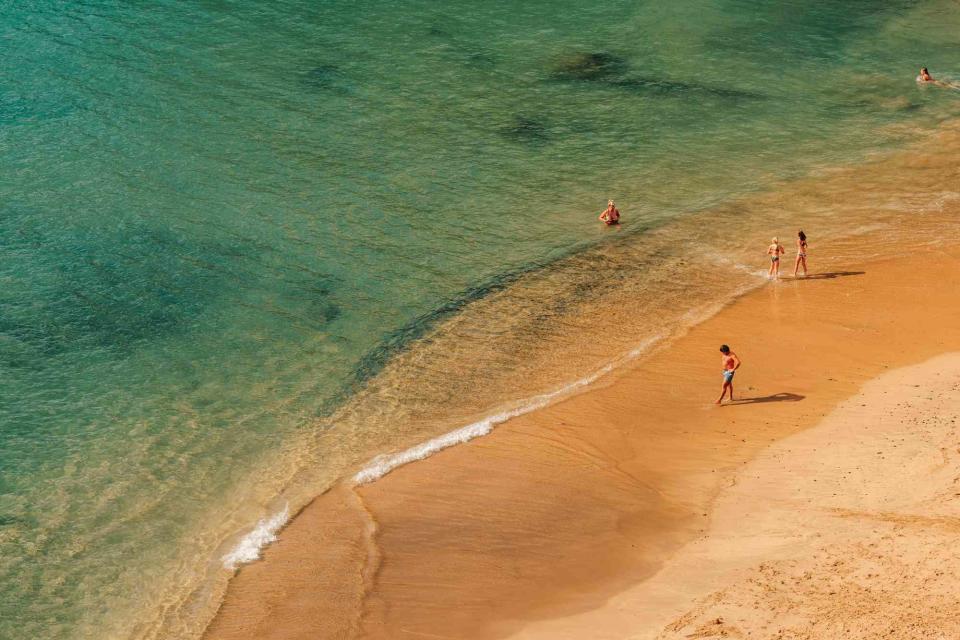
Salva LÓPEZ
Abama Beach, on Tenerife, one of the seven main Canary Islands.A few years ago, I left my home in Athens and settled on the Greek island of Tínos. I had never lived on an island before — let alone spent any prolonged amount of time in a place without an airport — but I quickly adjusted. Islands are detached in all senses of the word: time moves differently, and communities are usually more self-sufficient. Surrounded by horizon and only able to leave by boat, I fell in love with the harmonious way islanders live, and became fascinated by the way nature and the elements rule everyday life.
And then I started learning about the Canary Islands.
A Spanish archipelago of seven main islands and several islets scattered off the northwestern coast of Africa, the Canaries are an expression of geological and biologic diversity: damp laurisilvas (laurel forests), rocky deserts, temperamental volcanoes, tropical beaches. Each island has its own microclimate (in some cases, several) and its own particular energy.
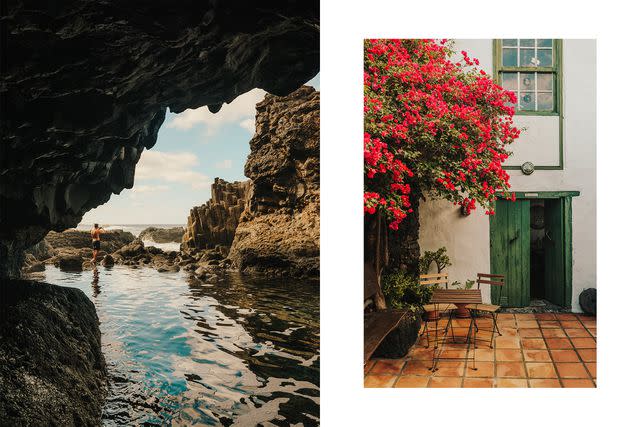
Salva López
From left: Charco Azul, one of the many natural volcanic pools on the island of El Hierro; El Sitio, a boutique hotel on El Hierro.But rugged, elemental landscapes aren’t necessarily the first thing that spring to mind when thinking of the Canaries. Starting in the 1960s, the two largest islands, Gran Canaria and Tenerife, became popular holiday spots for sun-starved northern Europeans, and a reputation for mass tourism was born. These were places to go to for a Club Med–like experience, a mai tai by the pool, and not much else.
I fell in love with the harmonious way islanders live, and became fascinated by the way nature and the elements rule everyday life.
I’m drawn to stereotypes — to unraveling them, that is. So in late June of last year, I flew to Tenerife, the most populous of the Canaries. I picked up a rental car from the airport and dropped my bags at the Ritz-Carlton, Abama, a sprawling resort on the beachy western coast. Its design is a nod to the architecture of North Africa, with wood-trimmed balconies and exteriors painted the same red color as the land around Pico de Teide, the island’s dormant volcano. The Ritz-Carlton is a particularly luxurious example of the many properties on Tenerife that are popular with couples and families — but it also makes an excellent base for exploring.
As I drove north through lush rolling hills, I passed a hand-painted sign: Fukuoka Farm. I performed an extremely illegal, screeching U-turn on the mountain road. The name of Masanobu Fukuoka, the Japanese farmer and philosopher who invented “do-nothing” farming, is a bat signal for certain types of agriculture-obsessed people; being one of them, I navigated my car down an unpaved dirt road to investigate. When I reached the end, I found myself warmly invited into a family home.
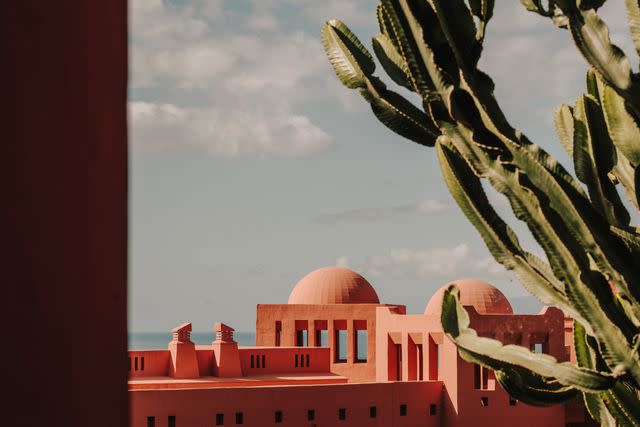
Salva López
A rooftop terrace at the Ritz-Carlton, Abama, on Tenerife.Federico Negrisolo and his partner, Romina, moved from their home in Italy to Tenerife nearly a decade ago, seeking a more intentional lifestyle — one intimately connected to nature and the rhythms of the seasons, away from urbanism and intense commercialization. “Living like this is a philosophy,” Negrisolo explained over tea in their living room. “We can’t fix decades of bad agricultural treatment of the earth in one day, but we can contribute.” They use Fukuoka’s methods to grow their own vegetables, like cabbage and lettuce, which they sell in local markets, and give tours to visitors by appointment.
The two insisted I stay for lunch, so I played with their toddler daughter and infant son while they prepared an omelette (with eggs from their chickens) and boiled potatoes. The soil on Tenerife is so full of minerals that even though they’d been prepared without any spices, the potatoes tasted like they’d been marinated for hours. Federico put a jar of powder in front of me: my first taste of gofio, a Canarian staple made from ground cereal (Romina makes hers from homegrown lentils). I tasted a spoonful and then promptly sprinkled it all over my plate.
Around the volcano, gigantic pieces of dried lava emerging from the ground, creating a tactile, alien landscape. I scrambled up rocks, the wind picking up speed around me. It felt like being in a geologist’s dream.
After a tour of the garden, the family sent me on my way, waving as I drove back up into the mountain fog. Then the weather changed, as it does constantly on Tenerife — some say this island alone has 28 distinct microclimates — and a hot wind propelled me back south toward the Ritz-Carlton pool.
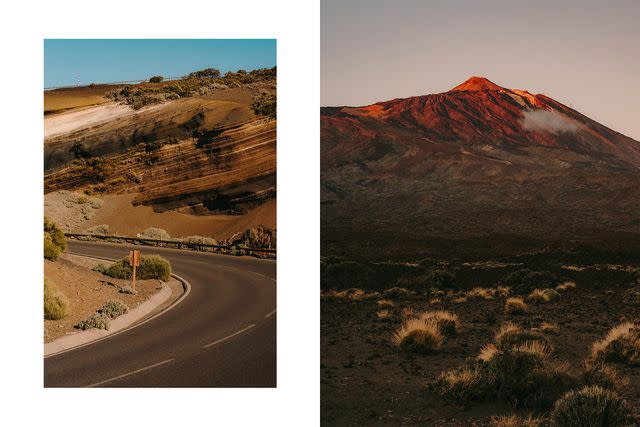
Salva López
From left: A road winds through Tenerife's Teide National Park; Pico de Teide rises from the center of Tenerife.The best explanation for the ever-changing weather came from the Guanche, the Indigenous people of the islands. They believed that Teide, Spain’s highest peak, was home to Guayota, the devil. His anger would make the earth tremble and the sun go dark; calm was restored by Achamán, the Supreme Being. Before the Spanish invasion in the 15th century, the Guanche would climb the mountain every summer with their flocks of goats.
Teide rises from the island’s middle like a ball of resting dough. Today there’s a cable car that takes visitors partway to the top, though strong winds had grounded it on the day I visited. Never mind — there was plenty to see around the volcano: gigantic pieces of dried lava emerging from the ground, creating a tactile, alien landscape. I scrambled up rocks, the wind picking up speed around me. It felt like being in a geologist’s dream.
More Trip Ideas: 15 most Beautiful Places to Visit in Spain
If a geologist dreamed up Tenerife’s center, then only a witch could have conjured the laurisilva in Anaga, on the island’s northeastern tip: this wild area of ravines and mountains is carpeted in bright-green laurel trees, their branches bent toward one another in secret conversation. At Anaga Rural Park, a damp mist floated through the scene; I gulped down big mouthfuls of fresh air. As I leaned in close to inspect a moss-covered branch, I noticed tiny, practically translucent mushrooms growing. At no point did I come across another soul. Everyone else must have been at the beach.
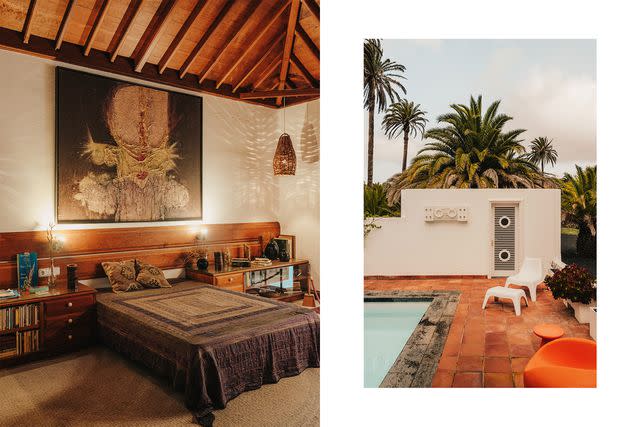
Salva López
From left: A bedroom at the César Manrique House Museum; the pool deck at the Manrique house.I found even fewer people on El Hierro, the smallest of the main islands and a UNESCO Biosphere Reserve that runs almost entirely on wind and hydroelectric power. I headed there by ferry from Tenerife; the boat pitched and rolled in the frothy Atlantic waves, but after 2½ hours I arrived, stomach more or less intact, at Puerto de la Estaca — a tiny port near the island’s capital, Valverde, where a handful of people were drinking coffee inside the terminal, waiting for the arrival of their loved ones.
El Hierro is at the westernmost edge of the archipelago, with a population of just 11,500; a sense of solitude immediately enveloped me as I drove through tunnels and around some of the island’s hundreds of volcanic cones. Often, my car was the sole vehicle on the road; the only radio station I could tune in to played melancholy Catholic hymns. Within El Hierro’s 104 square miles, there are tropical mountains, tide pools, barren plateaus, damp woodlands, and plunging gorges. As ideal a place as it is for hikers, it might be even better for divers: the sea along the southwestern end is a marine reserve.
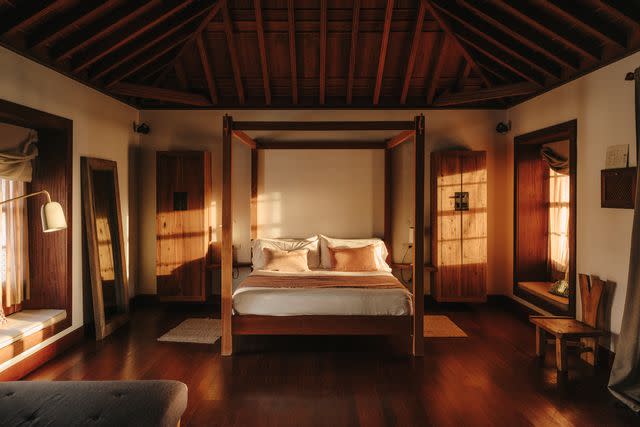
Salva López
One of Hotel Palacio Ico's guest rooms.There is little development on the island, and certainly no resorts, but on a wave-battered outcrop of volcanic rock I found Hotel Puntagrande, the island’s most fabulous hotel — or more accurately, hotelito, as it has only four rooms and one suite. Its owners, Italian David Nahmias and his Spanish-Colombian wife, Paula Pascual Luna, left their busy routines on mainland Europe five years ago in search of a more tranquil, nature-filled lifestyle. They have filled the stone fisherman’s house, built in 1830, with so many nautical items (including a vintage scuba suit) that the lobby and restaurant resemble a museum. In the guest rooms, floor-to-ceiling windows provide generous views of the Atlantic coastline and its fiery sunsets.
Related: 7 Europeans Explain How They Really Use All Their Vacation Time
Puntagrande could pass for a five-star hotel, and the restaurant could easily win awards for its five-course tasting menus. But as David told me, raising his eyes skyward, “We don’t need any Michelin stars. We have enough stars here.”
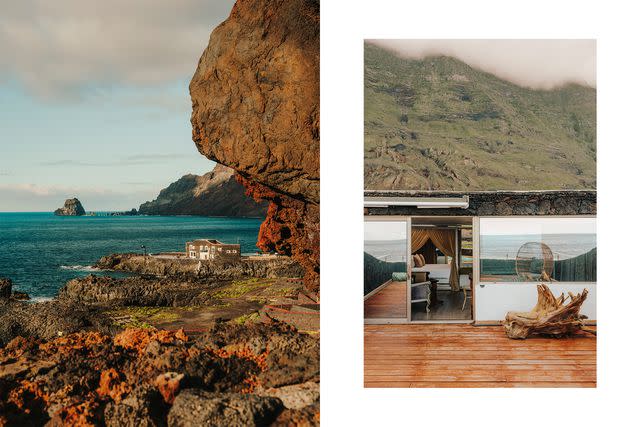
Salva López
From left: Hotel Puntagrande, built on a lava-rock outcrop on El Hierro; peeking into a guest room at Hotel Puntagrande.El Hierro doesn’t have the overcrowded, commercialized beaches of its neighbors; instead, people often swim in charcos, natural seaside pools that seem to have been carved by Poseidon himself. The result of ancient volcanic activity, they are scattered among the coastline’s coves, caves, and arches. Charco Azul, with its towers of hardened lava, looks like a smaller version of the Giant’s Causeway in Northern Ireland; evaporated puddles in the rocks had left behind crystalline sheets of sea salt, which I scraped into a plastic bag, a souvenir for my kitchen back home. At Charco Manso, I jumped into the tropical blue water and floated on my back, looking up at the shiny obsidian-black walls that surrounded me. I blinked: the rocks seemed to be moving. Swimming closer to inspect, I saw that the entire surface was covered in a layer of camouflaged black crabs, scuttling sideways over the rock face.
This island lends itself best to aimless driving and wandering, but I did have one planned activity in mind: a trip to the interpretive center at the Parque Cultural de El Julan, in El Hierro’s southwest. I was the only visitor in the glass-walled building; the landscape outside was scrubby and sunbaked, the greenery of the rest of the island having given way to burnt sienna.
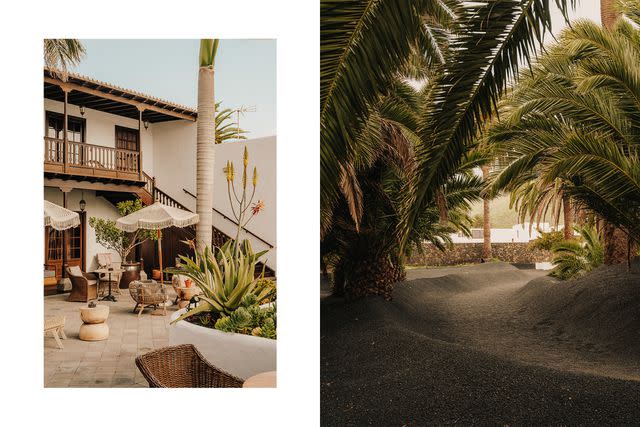
Salva López
From left: The courtyard of Hotel Palacio Ico, a historic inn on the island of Lanzarote; the grounds of the César Manrique House Museum, on Lanzarote.El Hierro was settled by the Bimbache people at least as early as A.D. 120, and while much about the Bimbache is today a mystery, I was astonished as I read a placard at the ethnographic exhibit: the Guanches, the ancestors of the Bimbache, were a Berber group originally from North Africa (perhaps Tunisia, my father’s country) and crossed the sea by canoe. They were particularly adept at foraging, both on the island and in the sea.
Despite an abundance of natural produce, cheeses, and seafood, El Hierro has not been known for its food scene. But the 2021 opening of the restaurant 8Aborigen began to change that. Inspired by his own Indigenous background and what archaeologists have discovered about Bimbache culinary culture, chef Marcos Tavío has created a fine-dining experience that reenvisions Canarian ingredients and flavors. Unlike other restaurants on El Hierro, which import some of their seafood from as far away as Norway, everything at 8Aborigen is local.
More Trip Ideas: 15 Remote Islands You Can Actually Visit
During my lunch there, attentive servers brought out earthenware pottery (all replicas of archaeological finds from around the archipelago) that revealed thoughtful interpretations of a long-forgotten cuisine: unleavened Berber-style bread, served warm with fermented goat butter and cheese; gofio crumble made from native barley; lapas (limpets) served with a mojo made of sea fennel. Dessert was a “Berber cheesecake” made from goat-milk cheese, a gofio crust, and olive-oil foam.

Salva López
From left: A view through the laurel trees in Anaga, on Tenerife; Federico Negrisolo and his daughter at Tenerifeâs Fukuoka Farm.Of all the Canary Islands, I was most eager to see Lanzarote. Friends in Athens and Paris had told me about its natural wines: high in minerals, the soil produces grapes with an earthy, salty flavor, and Lanzarote wines are increasingly recognized on the mainland for their delicate, balanced body. But the unique climate has also forced winemakers to plant ingeniously. Scattered across the dark landscape are semicircles of volcanic rock that act as wind breakers; inside each ring, a bright green vine emerges.
I took a turboprop plane from El Hierro’s tiny airport — an experience that left me silently praying, white-knuckled — to transfer through Tenerife, then caught an only-slightly-larger plane to Lanzarote. It is named after the Genoese navigator Lanceletto Malocello, credited with the archipelago’s “rediscovery” in 1312. But its original name, in the native Guanche language, is more fitting: Tytheroygaka, said to mean “one that is all ocher.”
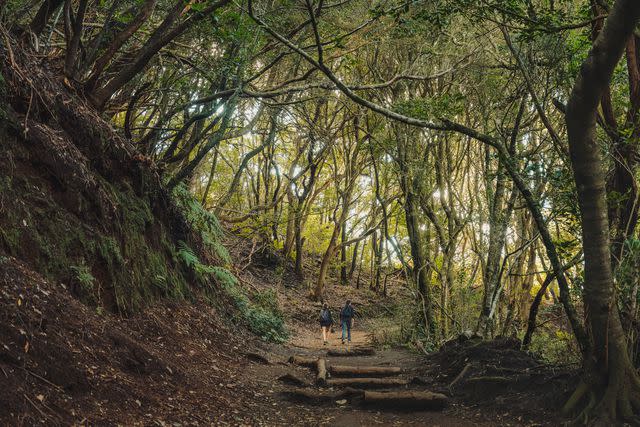
Salva López
Hikers in Anaga Rural Park, known for its mystical atmosphere.Periodically buffeted by the alisios, a hot seasonal wind, Lanzarote is defined by its volcanic features, from César Manrique’s famed Volcano House — built within air pockets in the volcanic rock — to the black-soil vineyards that produce the island’s distinctive minerally wines. Lanzarote seemed hotter and drier than El Hierro, which felt humid and tropical. I headed straight to Costa Teguise, a resort town on the eastern coast, and checked in to Alava Suites, a tranquil collection of guesthouses centered around a small plunge pool in a residential nook of town. Owner Maria Alava grew up in Lanzarote and returned home to open the hotel in 2019. “For me, Lanzarote means simplicity,” she told me. The sentiment was reflected in the clean, calm design of the hotel, where floor-to-ceiling windows looked out onto black-rock gardens peppered with flora that Alava had brought over from nearby Fuerteventura.
Alava Suites, like many of the structures on Lanzarote, was influenced by Manrique. The native-born architect, painter, and sculptor was obsessed with the idea of preserving the island’s natural beauty and protecting it from mass development and overtourism; in the 1980s, amid a construction boom on the islands, he lobbied the local government to protect traditional buildings and architectural techniques and prohibit roadside billboards.
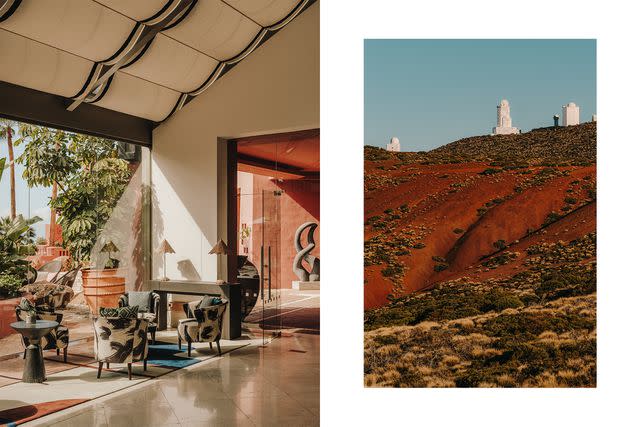
Salva López
From left: The lobby of The Ritz-Carlton Tenerife, Abama; a world-class observatory sits on the slope of Pico de TeideThe César Manrique Foundation has opened both the mind-bending, hedonistic 1968 Volcano House, where the artist once lived and worked, as a museum, along with the more conventional house and studio he later used. But my favorite Lanzarote building is by local Manrique collaborator Jesús Soto: LagOmar, named for Egyptian actor and heartthrob Omar Sharif. As the (unconfirmed) story goes, Sharif bought and subsequently lost the house in a card game; that’s good news for the rest of us, as its newest owners have opened it to the public. Built into a former quarry, it’s a labyrinth that wouldn’t look out of place in a James Bond movie.
I was reminded of something I’d seen earlier in the day while exploring the southern edge of the island: the volcanic rock had refracted the sunlight into a kaleidoscope of color — cobalt blue, deep purple, red, gold, and silver.
Some villages on the island hark back to the days of Spanish colonial rule — an intriguing contrast to Manrique’s surreal architectural empire. After lunch the next day I drove inland to Teguise — once the capital of the Canary Islands — just in time for siesta. I wandered the empty cobblestoned streets, the July heat dry and heavy in the air. The buildings were squat and whitewashed, with colorful wooden doors; the town’s main church kept watch over a square that, I was told, comes alive on market days. After a stroll, I checked in to the Hotel Palacio Ico, which was built as a family home in 1690. With its white walls, vaulted wooden ceilings, and shaded courtyard, it’s a classic example of the Lanzarotian aesthetic — Manrique included Palacio Ico in his reference book Lanzarote: Unpublished Architecture. In 2018, husband-and-wife team Sonsoles López and Eduardo Riestra turned the property into a nine-room hotel, preserving the original details and adding a few personal touches, like a collection of vinyl LPs.
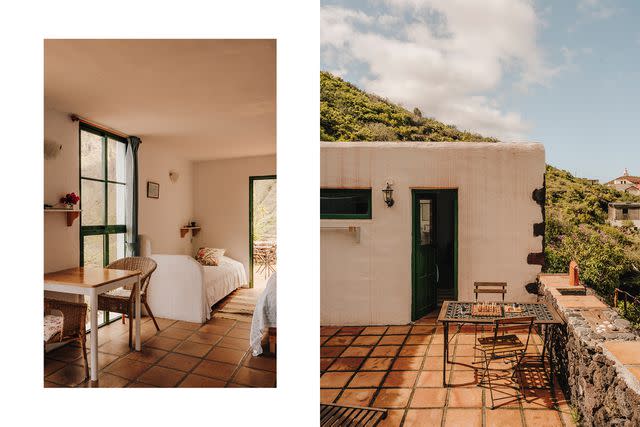
Salva López
The bedroom and terrace of an El Sitio guest house, on El Hierro.Waking up from a quick siesta in my airy room, I realized the sun was setting and I was late for dinner. I headed to SeBe, a restaurant opened a few years ago by Santi Benéitez and Begoña Ratón, who had moved to the island from the mainland. Today, SeBe is the island’s most sought-after reservation, and for good reason: the couple has paired Catalan culinary know-how with Canarian ingredients and inspiration. As a waiter served me a glass of the crisp local Puro Rofe wine, the first plate appeared: a cold leche de tigre with psychedelic dollops of prawn roe and green drops of spicy cilantro mojo oil. I was reminded of something I’d seen earlier in the day while exploring the southern edge of the island: the volcanic rock had refracted the sunlight into a kaleidoscope of color — cobalt blue, deep purple, red, gold, and silver.
But SeBe is best known for its rice dishes, cooked to crispy perfection in a wood-burning oven using the rectangular pan known as a llauna. Veronica insisted I try a version with dark-green rice and marine plankton, served with a huge slab of raw fatty tuna. The dish is meant for two people, but was so delicious that I ate nearly the whole thing.
After the check arrived, the island’s bounty filling my stomach, I went for a short walk along the port to stretch my legs. As the waves lapped lightly, the canopy of stars stretched out before me. The edge of the world had never felt so close at hand.
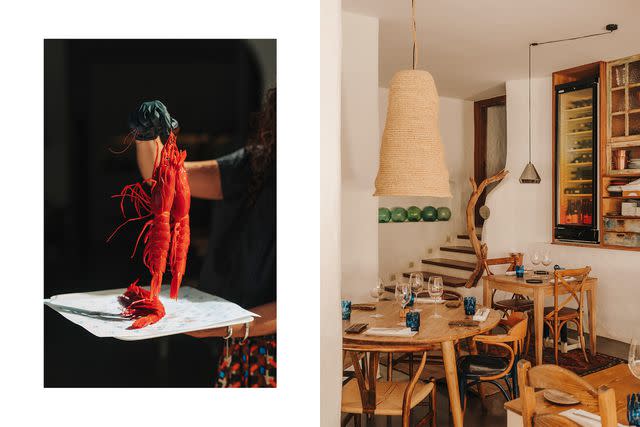
Salva López
From left: Lanzarote's famous carabineros de La Santa, bright-red prawns, at SeBe; the dining room at SeBe, in the resort town of Costa Teguise, on Lanzarote.Island-Hopping in the Canaries
Tenerife
Where to Stay
The Ritz-Carlton, Abama: This terra-cotta-red resort is large but still has a sense of privacy, with sea views and attentive staff. Abama Kabuki, one of two Michelin-starred restaurants on the property, deserves a visit.
Where to Eat
La Bola de Jorge Bosch: A chic guanchinche (traditional Canarian bistro) featuring local produce. The five-course prix fixe menu gives you all the highlights.
What to Do
Anaga Rural Park: Located within a UNESCO Biosphere Reserve, this popular hiking destination is known for its enchanting laurel forest.
Fukuoka Farm: An organic, low-intervention operation that sells vegetables and natural soaps at farmers’ markets and offers tours by appointment.
Teide National Park: Centered around the 12,000-foot Pico de Teide, this reserve is known for stark landscapes and endemic flora, like the Teide violet.
El Hierro
Where to Stay
El Sitio: Seven lovely bungalows amid lush greenery, run by German transplant Sabine Willmann.
Hotel Puntagrande: With a stunning location on a wave-battered promontory, this tiny inn is one of the most romantic stays in the Canaries.
Where to Eat
Con Fusion: Near Puntagrande, this spot is known more for ambience than food — on weekends, there’s live music under the stars.
8Aborigen: Fine-dining interpretations of Indigenous food make this El Hierro’s best restaurant, though it manages to stay unpretentious. Service is excellent, as is the wine list.
What to Do
Charcos: These cavelike coastal pools are perfect for a scenic swim; Charco Azul, with its bright-blue water, is one of the most famous.
Parque Cultural de El Julan: A reservations-required archaeological site with Bimbache petroglyphs and an informative visitors’ center.
Lanzarote
Where to Stay
Alava Suites: Six modern guest rooms have floor-to-ceiling windows that look out over landscaped gardens. Breakfast, which changes daily, can be delivered to your door.
Hotel Palacio Ico: A renovated 17th-century home built around a beautiful, sun-filled courtyard. Its restaurant highlights Lanzarote cheese, produce, and seafood.
Where to Eat
SeBe: Santi Benéitez and Begoña Ratón prepare Canarian ingredients with Iberian flair. The rice dishes are standouts.
What to Do
César Manrique House Museum: The late artist and architect, born on Lanzarote, designed many buildings and gardens around Spain and the Canary Islands. His former home in the village of Haría is open to the public.
LagOmar: Jesús Soto, a Manrique collaborator, designed this labyrinth of whitewashed buildings and hidden pools, reportedly owned, briefly, by Omar Sharif. It’s now on the market for $8 million — but still available to tour.
A version of this story first appeared in the June 2023 issue of Travel + Leisure under the headline "Earth, Wind, & Fire."
For more Travel & Leisure news, make sure to sign up for our newsletter!
Read the original article on Travel & Leisure.

